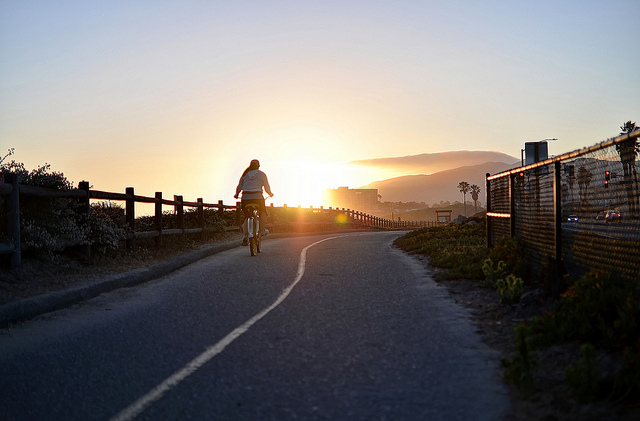Missed launch deadlines. Designs gone haywire. Huge backlogs of web copy.
What do these have in common? They're just a few things that biking and walking advocacy nonprofits can avoid if they manage a website build wisely.
Several Alliance member organizations recently completed website redesigns and rebuilds – as did the Alliance. In three cases, a website redesign provided a much-needed revamp for the organization's online presence and communications processes. In one case, an organization struggled with long delays and substandard work.
On a recent Mutual Aid webinar, we drew on expertise from Alliance members and our own experiences to discuss what nonprofit organizations should – and should not – do when approaching a web project. Watch the webinar recap and check out our ten tips below.
1. Dedicate a budget.

Image: epSos.de / Flickr
For us biking and walking advocates, it can be tempting to find a consultant who will do website work for free or at a steeply discounted rate. While this can be a good choice for a brand new organization, it's rarely the right choice for an established advocacy group. It's worth dedicating a real budget to a website redesign – even if it means scooping more out of your budget than you might like or waiting another year to save up.
Kristin Smith, Communications Director with the San Francisco Bicycle Coalition, recently led a redesign at her organization. Her advice: “If you can pay, it’s worth it. You’re going to get better work. Don’t undersell your value as an organization.”
Nicholas Mirra, Communications Coordinator at the Bicycle Coalition of Greater Philadelphia, agrees. "Web development is one of the things worth paying money for," he said. "Don’t get your cousin or volunteer to do it for free. It’s not going to be their priority. … It’s worth spending the money to get a well-working, well-designed website."
A leader at an Alliance member organization that is currently working through an inexpensive but difficult website redesign echoed this advice.
"Trying to do a website redesign without enough money is a common mistake, and it’s a mistake we made," said the advocate, who prefered to remain anonymous. "You definitely end up getting what you paid for. … In retrospect, I would have said 'we don’t have the resources to do a redesign, and we need to wait until we do.'"
How much your organization will need to pay will vary based on geographic area, choice of website tools, and the scope of the project. Shop an RFP around to several consultants in order to get a good sense of what your project is really worth.
2. Solve the problems that need solving.

Image: Cory Doctorow / Flickr
When approaching a redesign project, take time to ask yourself and your colleagues about the pain points are with your current website. What can’t you do now that you need to be able to do? What takes too long?
Maybe your organization needs a fresh look and a seamless connection between your site and your events registration system. Or maybe you need to be able to better control auto-responses when a supporter takes action online.
For the San Francisco Bicycle Coalition, a mobile-friendly design was important. Based on site analytics, Kristin knew that about 25% of site visitors were coming from mobile devices.
“We wanted to make sure that our site was mobile — so people could find ‘what to do in case of a crash’ and ‘how to take your bike on Muni’ on the go," she said.
Nicolas in Philadelphia wanted to migrate to a content management system that would give him more control over the site. “You don’t want to have to go back to your developer to make small changes.”
3. Bring people in.

Image: Joe Flood / Flickr
Your website isn’t just a home for pretty images and compelling content. It’s also a place to bring people into your work. Supporters should be able to engage with your organization – through online actions like joining, donating, and signing up for events.
Think about what actions you want your supporters to take, and make sure that the scope of your website project includes a plan to facilitate those connections.
Kristin in San Francisco, for example, wishes that she had prioritized list acquisition more at the start of their project. “Signing up for the petitions is pretty complicated from the back-end — we could have done a better job with that,” she said.
4. Find the right tools and builders.

Image: Alan Kotok / Flickr
Your website needs both a CMS and a CRM.
A Content Management System is a tool that dictates the architecture and design of your site and houses your content. You’ll write blog posts, add images, and edit your core pages through a CMS.
Here are some common Content Management Systems:
- Wordpress (used by the SF Bicycle Coalition and Bicycle Coalition of Greater Philadelphia)
- Nonprofit Soapbox (used by the Alliance for Biking & Walking)
- Drupal (used by the League of American Bicyclists)
A Contact Relations Management system is a tool that helps you manage your supporters. Depending on the system, your CRM may include signups, petitions, membership, event registration, donations, and email.
Here are some common CRMs:
- CiviCRM
- Action Kit
- Salesforce + Soapbox Engage (used by the Alliance for Biking & Walking)
- Convio
- Salsa (used by the Washington Area Bicyclist Association)
A few tools combine CRM and CMS into one. NationBuilder is an example of this.
Finding the right consultants is just as important as finding the right tools.
It’s important to find an individual or a company with staying power. You want to work with people who will be there to answer a question three years down the line when something goes wrong. Don’t just evaluate on price; also look at their track record.
The Alliance leader who is going through a difficult redesign process stressed the importance of working with the right person or company.
“Even if you feel like you don’t have time to do it, take the time to carefully select your contractors,” said the anonymous advocate. “There’s a tendency with web projects for it to not feel as big as it is. There are lots of folks who say they can do it low cost or pro bono or have it be an example project. Web projects are so big and complex that you can’t take that approach.”
“If I could go back, even though we had someone who was going to do it partially for free, I would have bid it to some other people and not just gone with it because it was partially pro bono,” they said.
“Even seeing other proposals would have helped us to get a scope of what the project was really worth. It could have helped us to understand that this was something beyond our current resources.”
Ultimately, this advocate’s organization “had a combination of the contractor being unrealistic about the timeline, not anticipating things going wrong, and unexpected personal delays.”
5. Design for your users.

Image: Ken Ohrn / Alliance photo library
A good design process has several stages. Consider the following steps:
An initial survey. Ask yourself and other at your organization some basic questions about your web presence. What do you like about your current website? What three values do you hope to express to your audience? What are three websites whose design you admire?
Analyze your analytics. If you have site metrics like Google Analytics set up, look at where people are currently spending the most time.
Kristin in San Francisco said, “We paid attention to the 25 most trafficked pages. We needed to make sure that those were on the new site. It gave us insight into what people were looking for.”
Audience and stakeholder surveys. Create formal or informal surveys for your supporters and for people who are core to your organization. Questions could include:
- Does the current website help you understand the purpose of the organization?
- The last time your visited our website, what were you looking for? Did you find it?
- Are you aware of our membership offerings?
User personas. At the San Francisco Bicycle Coalition, Kristin and her team “started out by creating different personas for the type of user that might be coming to our site and communities we wanted to make sure we were reaching.”
They invented profiles of the types of people who comprise the organization’s target audiences. For example:
- Jose is a donor and long-time member who wants to be able to give to the projects that are most important to him.
- Mary is a mom who lives in the western part of the city and wants to learn how to bike safely with her kids.
- Tailor is a 20 year old hipster in the Mission and bikes around the city.
“We built the website to serve all those different people with different needs,” said Kristin. Throughout the design process, she and her team would ask themselves, “Does this navigation make sense for Mary?”
Rounds of design comps and feedback. You and your consultants should agree in advance on a certain number of rounds of sample designs and opportunities for feedback. For a smoother process, keep to this schedule.
6. Seek input, but choose one captain.

Image: textfstop / Alliance photo library
A website redesign will be an easier process if your organization empowers one person to lead the project.
“Trying to do it as a collaborative effort is asking for delays,” said Nicolas.
Kristin agreed, and noted that “team involvement can be a place of super-delays.” It’s “really important for the organization to empower one or at most two to own and drive the project,” she said.
Of course, it’s important to seek input from staff and from people outside the organization at certain points. Nicholas said, “I sought and collected staff feedback at multiple stages, but I was the person talking to the developers, conveying what we were going for, distilling feedback.”
He also showed early designs to people outside the organization.
The San Francisco Bicycle Coalition also sought input from outside advisors early on in the process. A project lead can treat this process as a series of informational interviews.
7. Set a clear timeline.
Your consultant should set a timeline with you. (If a timeline isn’t a part of their process, this is a red flag!)
But do expect delays. “It’s going to take longer than you think it will,” said Nicholas.
It’s important for your timeline to include deadlines for your organization as well as deadlines for the consultant. An anonymous Alliance leader encouraged the project lead to “estimate where the staff time is going to be in terms of giving feedback, testing, cleaning up content, etc. If you can, bake the feedback moments into the project timeline.”
You can minimize delays by making sure that your organization sticks to your half of the timeline. Nicholas says that their delays were “half us and half them. If you drag your feet, it slows them down, too.”
Kristin agreed: “It gets slow if the firm is waiting for you to create page content. Almost all our delays were on the advocates’ side.”
8. Rethink normal.

Image: Barry Lewis / Alliance photo library
Your website can completely change during a redesign. If there are things about your site that aren’t great, now is the time to change them.
For example, a redesign is a great time to rethink your information architecture.
Kristin said that the SF Bicycle Coalition spent over half of their time on information architecture. “We were really deliberate about how information was going to be laid out,” she said. “We spent a lot of time moving things from one category to another, renaming stuff. …We wanted to make sure that there was a clear logic to everything and the site took you to the pages you want to go.”
At the Alliance, we threw our old site architecture out the window and started fresh. We defined which pages we would need, arranged them on a wall as sticky notes, and rearranged and added and subtracted until we were satisfied. Then, I rewrote fresh content for all our pages.
Kristin rewrote most of the SF Bicycle Coalition’s content, too. “It was a huge workload, but moving outdated and poorly done content and then editing it later is more work than moving clean, newly done content over.”
A redesign is a good opportunity to automate things that were previously time-consuming. For example, both the SF Bicycle Coalition and the Bicycle Coalition of Greater Philadelphia built campaign pages that include widgets that automatically update when the organization posts blogs about that campaign.
9. Reinforce your brand.

Image: tarheelcoxn / Alliance photo library
Your new website should look like it fits with your organization.
The Alliance’s site has a lot of green. SFBC’s site makes use of orange highlights. The color and feel of the BCGP site matches their new logo. Aesthetics matter.
10. Stay in touch when you're done.

Image: intherough / Alliance photo library
After the project is done, there will invariably be things you need help with or need to change. Make sure you still have contact with your consultant so that they can help you address the things that come up.
“You’re going to realize after it’s up that there are little changes you want to make or things you wish you had done differently,” said Nicholas. “It’s inevitable.”

